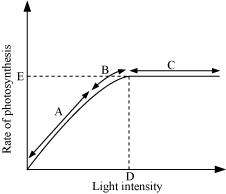 Short Answer Type
Short Answer TypeThe leaves on the shady side or those kept in the shade have leaves that are darker green. This is because light is a limiting factor for photosynthesis. In order to increase the rate of photosynthesis, the leaves present in shade have more chlorophyll pigments. This increase in chlorophyll content increases the amount of light absorbed by the leaves, which in turn increases the rate of photosynthesis.
 Long Answer Type
Long Answer TypeFigure 13.10 shows the effect of light on the rate of photosynthesis. Based on the graph, answer the following questions:
(a) At which point/s (A, B or C) in the curve is light a limiting factor?
(b) What could be the limiting factor/s in region A?
(c) What do C and D represent on the curve?

 Multiple Choice Questions
Multiple Choice QuestionsA plant in your garden avoids photorespiratory losses, has improved water use efficiency, shows high rate of photosynthesis at high temperatures and has improved efficiency of nitrogen utilisation. In which of the following physiological groups would you assign this plant?
C4
CAM
Nitogen-fixer
Nitogen-fixer
Emerson's enhancement effect and red drop have instrumental in the discovery of
two photosystems operating simultaneously
photophosphorylation and cyclic electron transport
oxidative phosphorylation
oxidative phosphorylation
Specialised epidermal cells surrounding the guard cells are called
sunbsidiary cells
bulliform cells
lenticels
lenticels
The three boxes in this diagram represent the three major biosynthetic pathways in aerobic net reactant or products
Arrows numbered 4, 8 and 12 can all be
NADH
ATP
H2O
H2O
